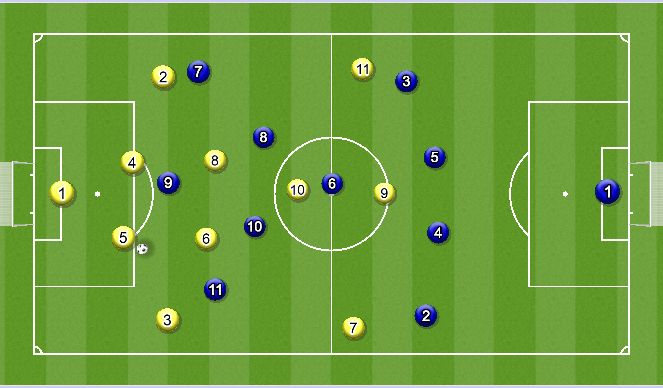Football/Soccer Session (Moderate): Overload Switch of Attack (Playing Behind the Defense not tracking the Internal Runs)
Profile Summary

| Name: | Todd Abbey |
|---|---|
| City: | Fayetteville |
| Country: | United States of America |
| Membership: | Adult Member |
| Sport: | Football/Soccer |








 Play animation
Play animation Play step-by-step
Play step-by-step Repeat (toggle)
Repeat (toggle) Full Screen
Full Screen Pause
Pause Stop
Stop
Overload Switch of Attack
The Objective is to get the opposing team to overload one side of the field from the original pass in order to play the ball behind the defense that does not track the movement of the attackers.
Movements:
1. When the initial ball is played, either by the keeper (1) or the Central Back (5), we see the Flank player on the ball side (7) check back and wide in order to draw the opposing team's outside back (2) in towards the midfield and wide. Also, the Striker (9) checks into the midfield as well trying to pull the near side opposing center back (4) with him as well. This will allow the weak side flank player (11) to move underneath the back line, drawing the attention of the other central defender (5) towards the middle of the field. In this scenario, the opposing (3) stays and does not shift with the (11) because he stays to mark our (2) coming up the wing.
2. Once the ball is played from the (3) into the (7), the near side central defending midfielder (6) checks into space to create a angle supporting pass for the (7), with the next intention on opening up and playing a long diagonal ball into the (2) that has occupied the space left by the (11). The central attacking midfielder (10), checks in at an angle passing lane in order to pull the opposing teams (6) with them, causing the overload to the ball side of the field. The other central defending midfielder (8) stays at a deep supporting roll to allow for a square pass if the long ball is cut off, but also for defensive structural purposes in the case of a counter-attack. In this example, you can now attribute new numbers if you would like to your players for coaching purposes. (9) > (10); (11) > (9); (2) > (11); (8) > (6)
3. Now, because the opposing (3) stayed, the wanted pass to the (6) to switch the field is not on. This needs to be identified and communicated early. As the pass is being made from the (3) to the (7). Something along the lines of "No Switch!". This will tell the (7) that we need to look for another option. Starting Phase 3 of the Overload.
4. Once the Communication is awarded to the (7) prior to receiving the pass, he will now play a wall pass (or 1-2) with the (9), who in-turn will play him up the line. The (7) will have beaten the opposing (2) with the wall pass and subsequent run, thus drawing the shift of the opposing (4) that is marking the (9).
5. As the opposing (4) comes to mark the (7), we are looking for an early ball either near post to the (11) who can either try to finish or play across to the (10) who has made a run centrally between the opposing (5) and (3). Or... the (7) can try to hit the on-rushing (10) themselves with an early ball into the box. For this example we have the following combination (7>11>10)
Notice: Defensively we are now back to a well-organized four back system with our (8) playing the (4) role, the (6) sliding back in the hole, the (3) reconnecting with our (5) and the (4) shifting to the (2) role in the case of a counterattack.